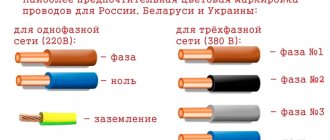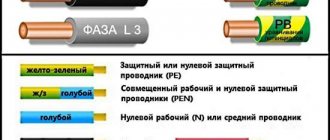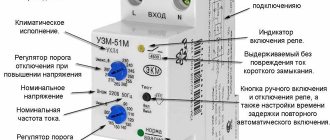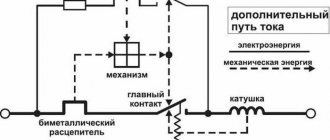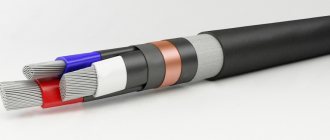Let's figure out what the designations L and N mean in electrical engineering.
As you probably guessed, these are not just arbitrary symbols, each of them carries a specific meaning and serves as a hint for correctly connecting the electrical appliance to the network.
“ L ” - This marking came to electrical engineering from the English language, and it is formed from the first letter of the word “Line” (line) - the generally accepted name for a phase wire. Also, if it is more convenient for you, you can focus on such concepts of English words as Lead (lead wire, core) or Live (under voltage).
Accordingly, the designation L marks the clamps and contact connections intended for connecting the phase wire. In a three-phase network, alphanumeric identification (marking) of phase conductors “L1”, “L2” and “L3”.
According to modern standards (GOST R 50462-2009 (IEC 60446:2007)) in force in Russia, the colors of phase wires are brown or black. But often, white, pink, gray or a wire of any other color except blue, white-blue can be found , blue, white-blue or yellow-green.
“N” is a marking formed from the first letter of the word Neutral (neutral) - the generally accepted name for the neutral working conductor, in Russia more often called simply the neutral conductor or briefly Zero (Zero). In this regard, the English word NULL (zero) is well suited, you can focus on it.
the designation N marks clamps and contact connections for connecting the neutral working conductor/neutral wire. Moreover, this rule applies to both single-phase and three-phase networks.
The colors of the wire that mark the neutral wire (zero, zero, zero working conductor) are strictly blue (light blue) or white-blue (white-blue).
Source: RozetkaOnline.ru
The nuances of manual color marking
Manual marking is used when using wires of the same color in old buildings. Before starting work, a diagram with the color values of the conductors is drawn up. During the installation process, you can mark current-carrying conductors:
- standard cambrics;
- cambrics with heat shrinkage;
- insulating tape.
The rules allow the use of special marking kits. The installation points for markers to indicate zero and phase are indicated in the PUE and GOST. These are the ends of the wire and where it connects to the bus.
Specifics of marking a two-core wire
If the cable has already been connected to the network, you can use an indicator screwdriver. The difficulty in using the tool lies in the inability to determine multiple phases. You will need to test them with a multimeter. To prevent confusion, you can color-code the electrical conductor:
- choose heat-shrinkable tubes or electrical tape to indicate zero and phase;
- work with conductors not along their entire length, but only at the junctions and joints.
Methods for marking wiring during installation
There are various ways to mark cables. This is necessary for correct connection and safety, since information on the color shades of the cable sheath is not always enough. Therefore, special symbols are applied to the wires, indicating the brand of the cable, its purpose, and the object associated with it; length, etc.
Types of markers:
- Cambrics. There are several types: heat shrink or PVC. A cambric is a tube placed on a wire at the point of connection or damage to the insulation.
- Heat shrink tubes. The most reliable and durable.
- Self-laminating. This is an adhesive film with a transparent shell. Provides wire protection even when heavily soiled.
- Tags. Made from polymers in white and yellow colors.
- Ties.
- Checkboxes.
- Labels. Used for thin wires.
- Sleeves and containers.
- Rings, clips. Convenient for short markings.
- PKH and POH sites.
The use of various types of markings makes it easier for electricians and ordinary people to work with the electrical network.
Color of zero, neutral
The “zero” wire should be blue
. In the distribution board it must be connected to the zero bus, which is designated by the Latin letter N. All blue wires must be connected to it. The bus is connected to the input via a meter or directly, without additional installation of the machine. In the distribution box, all wires (except for the wire from the switch) of blue color (neutral) are connected and do not participate in switching. To the sockets, the blue “zero” wires are connected to the contact, which is designated by the letter N, which is marked on the back of the sockets.
Wiring colors speed up electrical installation
Painted conductor insulation significantly speeds up the work of the electrician.
In the old days, the color of the conductors was either white or black, which generally brought a lot of trouble to the electrical installer. When disconnecting, it was necessary to supply power to the conductors in order to use a control to determine where the phase is and where the zero is. The coloring saved me from this torment, everything became very clear.
The only thing that should not be forgotten when there is an abundance of conductors is to mark, i.e. sign their purpose in the distribution board, since there can be from several groups of conductors to several dozen supply lines.
Ground wire color
From 01/01/2011 the color of the grounding (or grounding) conductor can only be yellow-green. This color marking of wires is also observed when drawing up diagrams on which such conductors are signed with the Latin letters PE. The coloring of one of the conductors on cables is not always intended for grounding - usually it is done if there are three, five or more conductors in the cable.
PEN wires with combined “ground” and “zero” deserve special attention. Connections of this type are still often found in old buildings, in which the electrification was carried out according to outdated standards and has not yet been updated. If the cable was laid according to the rules, then blue insulation was used, and yellow-green cambrics were put on the ends and joints. Although, you can also find the color of the grounding (grounding) wire exactly the opposite - yellow-green with blue tips.
Protective grounding is mandatory when laying lines in residential and industrial premises and is regulated by PUE standards and GOST 18714-81. The neutral grounding wire should have as little resistance as possible, the same applies to the grounding loop. If all installation work is carried out correctly, then grounding will be a reliable protector of human life and health in the event of a fault in the power line. As a result, correctly marking cables for grounding is critical, and grounding should not be used at all. In all new houses, wiring is done according to the new rules, and old ones are put in line for replacement.
If the cable does not contain the required color
It may happen that the purchased electrical cable does not have the color that we want to use in the electrical installation, for example brown. What to do then?
Simply take a wire of a different color (for example, gray) and connect it to a neutral conductor. Then we take electrical tape (or heat shrink tubing of the desired color) and mark the cable at both ends. Thanks to this, we will know that a change has been introduced here.
Connecting a PEN conductor in a private house
In a private house or cottage, it is quite simple to organize a grounding system, but there is a need for phase protection from overvoltage and lightning protection. In this case, a “fire” and selective residual current device is required. Splitting the PEN neutral conductor is not a problem and should be done everywhere.
Energy regulators may require that the PEN conductor be separated after the electricity meter. This is done to prevent electricity theft. Such a connection is acceptable, but it would be correct to separate it before the meter, it will be more reliable. Watch the video of a professional:
The PUE requirements provide comprehensive recommendations on the issue of separating the PEN conductor, regardless of the location and method of connection, study and apply. Good luck with business!
Is there anything to add to the material? LEAVE A COMMENT
PE protection line color
The protective conductor is marked in yellow and green. As the name suggests, it has the task of protecting a person from electric shock.
The protective conductor is literally connected to the ground, the main protective line ends with a wire or flat steel rod buried in the ground. If there is no connection to ground, the protective conductor is connected to the neutral conductor N in the fuse box in the apartment (or in each electrical outlet separately, when there are no protective conductors in the entire apartment - this mainly applies to older wiring).
This cable is most often connected from the inside of the device to elements that are within human reach, that is, the metal case. If the device is damaged (for example, a phase wire touches the body from the inside), and electrical voltage (potential) appears on the body, current will flow in this wire along the line of least resistance to ground. And when the protective conductor is not connected, if a person touches the body, he will become the line of least resistance - he will get hit!
Using information about wiring colors during installation
Imagine if all cables were the same color. You open the switchboard - and how to find the required wire? Only with the help of a tester - a special indicator screwdriver. By touching the end of the bare wire, see if the indicator lights up - this means that the wire is phase. If the indicator does not light, it is zero.
Knowing the color codes speeds up the search time for the cable you need, and also ensures safety when working with the electrical network.
How to determine ground, zero and phase on wires if there are no markings
It is more difficult to determine in practice than in theory. Not all manufacturers comply with the standards. Therefore, when laying a two-phase 220 V network with grounding, you have to use a VVG cable with blue, brown and red colors. Combinations may be different, but without complying with regulatory requirements.
For your information. In old wiring from “Soviet times” there is no color marking. Identical white (gray) shells do not allow the purpose and correspondence of the lines to be known by simple visual inspection.
To avoid problems, it is recommended to carry out installation work using the same type of cable products. When color coding is not available, it should be created at the joints using insulating tape or heat shrink tubing. The latter option is preferable, as it is designed to maintain integrity for a long time.
Below are methods for determining phase and neutral wires with the advantages and disadvantages of each option. In any case, first clarify the network parameters. In old houses, for example, a two-wire connection scheme with a single working and grounding conductor is often used.
The figure shows a modern network with separate grounding and working zero connections. It is possible to connect three- and single-phase loads.
Determining the phase using an indicator screwdriver
Touching the tip of such a device to the phase wire closes the current circuit. This is accompanied by the warning lamp or LED lighting up. A built-in resistor limits the current to a safe level.
Advantages of the indicator:
- minimum cost;
- compactness;
- reliability;
- durability;
- autonomy;
- good protection from adverse external influences.
The disadvantage is the limited measurement accuracy. Under certain conditions, false positives cannot be ruled out.
Determination of ground, zero and phase using a test lamp
To reproduce this technology, you need to prepare a simple design. An incandescent lamp designed for the appropriate mains voltage is screwed into a standard socket. Connect wires of sufficient length to perform work operations in a specific location.
Next, connect one of the wires to the known zero line. Others sequentially check other cable cores. Lighting of the lamp indicates the presence of a phase.
Using a measuring device
When checking a 220 V household network, you do not need to know how to determine the polarity. The power supply is organized using alternating current, so set the multimeter switch to the appropriate position. Touching the phase-zero (phase-ground) wires with the probes is accompanied by an indication of the corresponding voltage (≈220 V). The potential difference between the neutral conductor and ground is minimal.
For your information. When checking an old two-wire circuit, one of the probes touches the reinforcement in a concrete slab, a radiator of a heating system, or another grounded element of a building structure.
When switching to constant voltage, the multimeter will show where the plus and minus are. In the absence of reliable information about the electrical parameters in the circuit, they begin with the maximum measurement range with a sequential transition to smaller values with insufficient accuracy.
Such a “device” is useful for testing DC circuits in the absence of specialized measuring instruments. Bubbles near the negative wire are the release of hydrogen during the electrolysis reaction. The area near the plus will take on a greenish tint after a few minutes.
Using LED
You can create a control device with your own hands by analogy with an indicator screwdriver. Instead of a light bulb, install AL 307 or another LED with similar characteristics. A 100-120 kOhm resistor with a power of 1-2 W is added in series to the circuit.
Marking of wires in a DC network
The DC network includes only a positive (+) and a negative (-) bus. According to the standards, wires (tires) with a positive charge are painted red. Wires (tires) with a negative charge are painted blue. The middle conductor, if there is one, is blue.
In the case where a two-wire DC electrical network is made by branching from a three-wire network, the positive wire of the two-wire network is marked in the same way as the positive wire of the three-wire circuit to which it is connected.
The need to check the labeling
The designation LO, L, N in electrical engineering when installing electrical networks is an important detail. How can I check if the color coding is correct? To do this you need to use an indicator screwdriver.
To determine which of the conductors is phase and which is neutral using an indicator screwdriver, you need to touch the uninsulated part of the wire with its tip. If the LED lights up, it means that a phase conductor has been touched. After touching the neutral wire with a screwdriver, there will be no glowing effect.
The importance of color marking of conductors and strict adherence to the rules of its use will significantly reduce the time of installation work and troubleshooting of electrical equipment, while ignoring these basic requirements results in a health risk.
Additional marking of wires
If the purchased cable has conductors of a color that does not comply with the standards, or the wiring has already been laid and is incorrectly marked, additional identification must be carried out.
Additional marking of wires
During the electrical installation process, the ends of the wires are marked using heat-shrinkable tubing or colored insulating tape. Additionally, the letter designation of the cores can be applied to the wire or a tag attached to the wire:
- L – phase.
- N – neutral (working zero).
- PE – ground (protective grounding).
Colors for neutral wire
For “zero” (or zero working contact) only certain wire colors are used, also strictly defined by electrical standards. It can be blue, light blue or blue with a white stripe, regardless of the number of cores in the cable: a three-core wire in this regard will be no different from a five-core wire or with an even larger number of conductors. In electrical circuits, “zero” corresponds to the Latin letter N - it participates in closing the power supply circuit, and in circuit diagrams it can be read as “minus” (phase, respectively, is “plus”).


